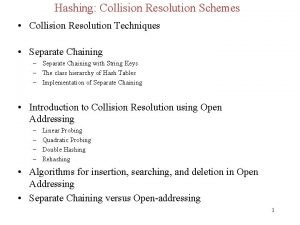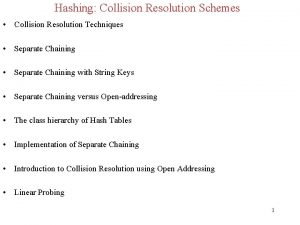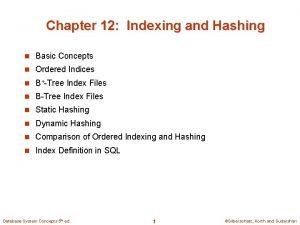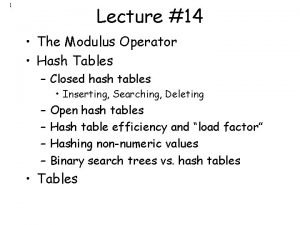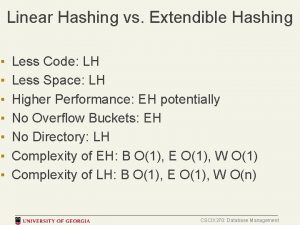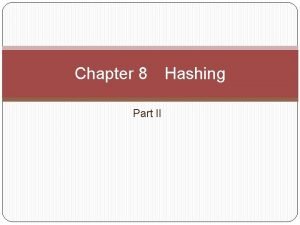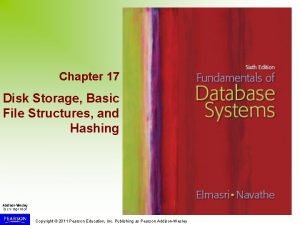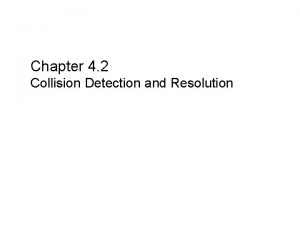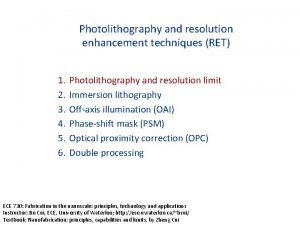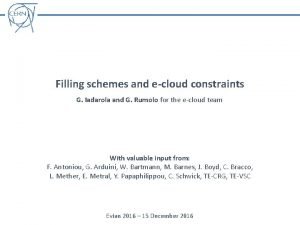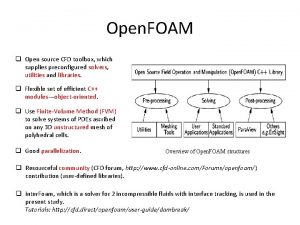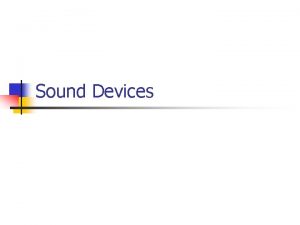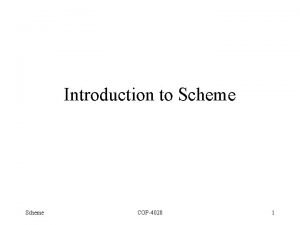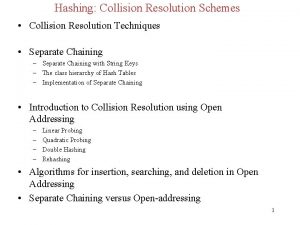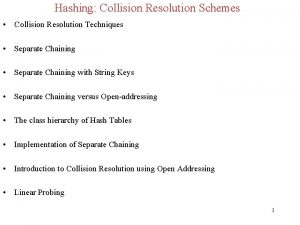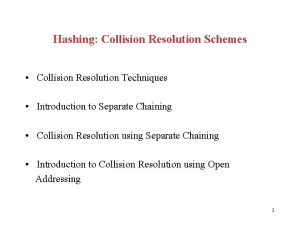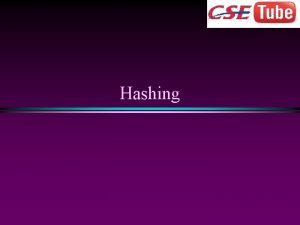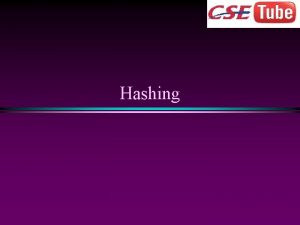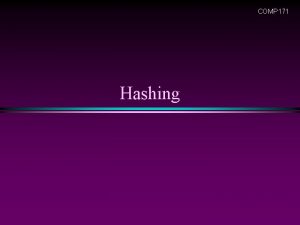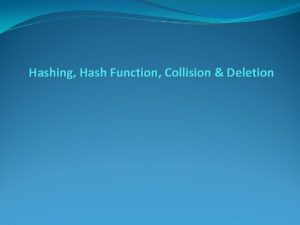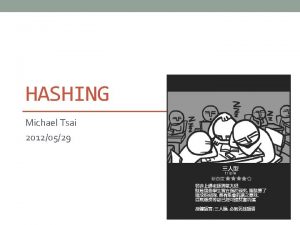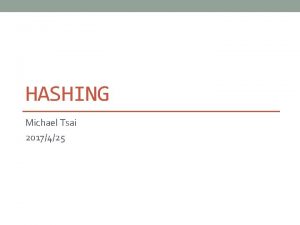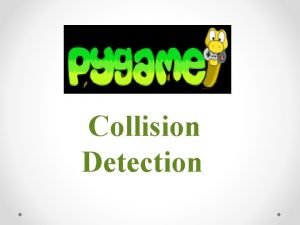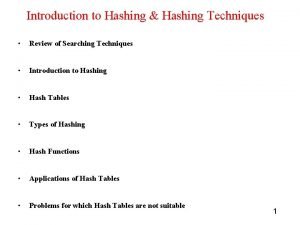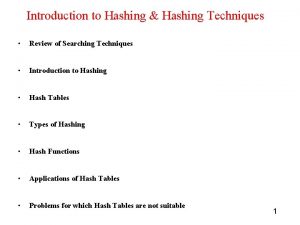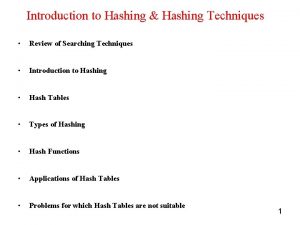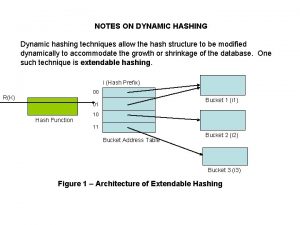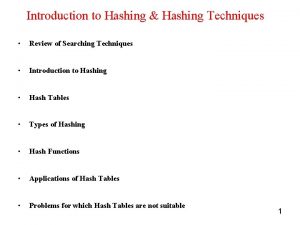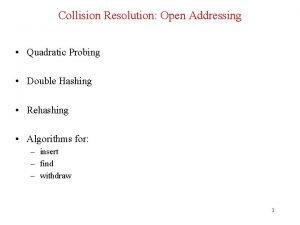Hashing Collision Resolution Schemes Collision Resolution Techniques Separate
























![Double Hashing (cont’d) hi(key) = [h(key) + i*hp(key)]% 13 h 0(18) = (18%13)%13 = Double Hashing (cont’d) hi(key) = [h(key) + i*hp(key)]% 13 h 0(18) = (18%13)%13 =](https://slidetodoc.com/presentation_image_h/c3afd57cda8b728572b06606503469ae/image-25.jpg)
![Double Hashing (cont'd) hi(key) = [h(key) + i*hp(key)]% 13 h 0(18) = (18%13)%13 = Double Hashing (cont'd) hi(key) = [h(key) + i*hp(key)]% 13 h 0(18) = (18%13)%13 =](https://slidetodoc.com/presentation_image_h/c3afd57cda8b728572b06606503469ae/image-26.jpg)

![Implementation of Open Addressing public class protected Open. Scatter. Table Entry array[]; static final Implementation of Open Addressing public class protected Open. Scatter. Table Entry array[]; static final](https://slidetodoc.com/presentation_image_h/c3afd57cda8b728572b06606503469ae/image-28.jpg)






- Slides: 34

Hashing: Collision Resolution Schemes • Collision Resolution Techniques • Separate Chaining – Separate Chaining with String Keys – The class hierarchy of Hash Tables – Implementation of Separate Chaining • Introduction to Collision Resolution using Open Addressing – – Linear Probing Quadratic Probing Double Hashing Rehashing • Algorithms for insertion, searching, and deletion in Open Addressing • Separate Chaining versus Open-addressing 1

Collision Resolution Techniques • There are two broad ways of collision resolution: 1. Separate Chaining: : An array of linked list implementation. 2. Open Addressing: Array-based implementation. (i) Linear probing (linear search) (ii) Quadratic probing (nonlinear search) (iii) Double hashing (uses two hash functions) 2

Separate Chaining • The hash table is implemented as an array of linked lists. • Inserting an item, r, that hashes at index i is simply insertion into the linked list at position i. • Synonyms are chained in the same linked list. 3

Separate Chaining (cont’d) • Retrieval of an item, r, with hash address, i, is simply retrieval from the linked list at position i. • Deletion of an item, r, with hash address, i, is simply deleting r from the linked list at position i. • Example: Load the keys 23, 13, 21, 14, 7, 8, and 15 , in this order, in a hash table of size 7 using separate chaining with the hash function: h(key) = key % 7 h(23) = 23 % 7 = 2 h(13) = 13 % 7 = 6 h(21) = 21 % 7 = 0 h(14) = 14 % 7 = 0 collision h(7) = 7 % 7 = 0 collision h(8) = 8 % 7 = 1 h(15) = 15 % 7 = 1 collision 4

Separate Chaining with String Keys • Recall that search keys can be numbers, strings or some other object. • A hash function for a string s = c 0 c 1 c 2…cn-1 can be defined as: hash = (c 0 + c 1 + c 2 + … + cn-1) % table. Size this can be implemented as: public static int hash(String key, int table. Size){ int hash. Value = 0; for (int i = 0; i < key. length(); i++){ hash. Value += key. char. At(i); } return hash. Value % table. Size; } • Example: The following class describes commodity items: class Commodity. Item String name; int quantity; double price; } { // commodity name // commodity quantity needed // commodity price 5

Separate Chaining with String Keys (cont’d) • Use the hash function hash to load the following commodity items into a hash table of size 13 using separate chaining: onion tomato cabbage carrot okra mellon potato Banana olive salt cucumber mushroom orange 1 1 3 1 1 2 2 3 3 2 10. 0 8. 50 3. 50 5. 50 6. 50 10. 0 7. 50 4. 00 15. 0 2. 50 4. 50 5. 50 3. 00 • Solution: hash(onion) = (111 + 110 + 105 + 111 + 110) % 13 = 547 % 13 = 1 hash(salt) = (115 + 97 + 108 + 116) % 13 = 436 % 13 = 7 hash(orange) = (111 + 114 + 97 + 110 + 103 + 101)%13 = 636 %13 = 12 6

Separate Chaining with String Keys (cont’d) 0 okra potato 1 onion carrot 2 3 4 cabbage 5 6 mushroom 7 salt 8 9 cucumber 10 tomato 11 banana 12 orange Item onion tomato cabbage carrot okra mellon potato Banana olive salt cucumber mushroom orange mellon Qty 1 1 3 1 1 2 2 3 3 2 Price 10. 0 8. 50 3. 50 5. 50 6. 50 10. 0 7. 50 4. 0 15. 0 2. 50 4. 50 5. 50 3. 00 h(key) 1 10 4 1 0 10 0 11 10 7 9 6 12 olive 7

Separate Chaining with String Keys (cont’d) • Alternative hash functions for a string s = c 0 c 1 c 2…cn-1 exist, some are: • hash = (c 0 + 27 * c 1 + 729 * c 2) % table. Size • hash = (c 0 + cn-1 + s. length()) % table. Size • hash = 8

Implementing Hash Tables: The Hierarchy Tree Container Abstract. Container Searchable. Container Hash. Table Abstract. Hash. Table Chained. Hash. Table Open. Scatter. Table 9

Implementation of Separate Chaining public class Chained. Hash. Table extends Abstract. Hash. Table { protected My. Linked. List [ ] array; public Chained. Hash. Table(int size) { array = new My. Linked. List[size]; for(int j = 0; j < size; j++) array[j] = new My. Linked. List( ); } public void insert(Object key) { array[h(key)]. append(key); count++; } public void withdraw(Object key) { array[h(key)]. extract(key); count--; } public Object find(Object key){ int index = h(key); My. Linked. List. Element e = array[index]. get. Head( ); while(e != null){ if(key. equals(e. get. Data()) return e. get. Data(); e = e. get. Next(); } return null; } 10 }

Introduction to Open Addressing • • • All items are stored in the hash table itself. In addition to the cell data (if any), each cell keeps one of the three states: EMPTY, OCCUPIED, DELETED. While inserting, if a collision occurs, alternative cells are tried until an empty cell is found. • Deletion: (lazy deletion): When a key is deleted the slot is marked as DELETED rather than EMPTY otherwise subsequent searches that hash at the deleted cell will fail. • Probe sequence: A probe sequence is the sequence of array indexes that is followed in searching for an empty cell during an insertion, or in searching for a key during find or delete operations. • The most common probe sequences are of the form: hi(key) = [h(key) + c(i)] % n, for i = 0, 1, …, n-1. where h is a hash function and n is the size of the hash table • The function c(i) is required to have the following two properties: Property 1: c(0) = 0 Property 2: The set of values {c(0) % n, c(1) % n, c(2) % n, . . . , c(n-1) % n} must be a permutation of {0, 1, 2, . . . , n – 1}, that is, it must contain every integer between 0 and n - 1 inclusive. 11

Introduction to Open Addressing (cont’d) • The function c(i) is used to resolve collisions. • To insert item r, we examine array location h 0(r) = h(r). If there is a collision, array locations h 1(r), h 2(r), . . . , hn-1(r) are examined until an empty slot is found. • Similarly, to find item r, we examine the same sequence of locations in the same order. • Note: For a given hash function h(key), the only difference in the open addressing collision resolution techniques (linear probing, quadratic probing and double hashing) is in the definition of the function c(i). Common definitions of c(i) are: • Collision resolution technique c(i) Linear probing i Quadratic probing ±i 2 Double hashing i*hp(key) where hp(key) is another hash function. 12

Introduction to Open Addressing (cont'd) • Advantages of Open addressing: – All items are stored in the hash table itself. There is no need for another data structure. – Open addressing is more efficient storage-wise. • Disadvantages of Open Addressing: – The keys of the objects to be hashed must be distinct. – Dependent on choosing a proper table size. – Requires the use of a three-state (Occupied, Empty, or Deleted) flag in each cell. 13

Open Addressing Facts • In general, primes give the best table sizes. • With any open addressing method of collision resolution, as the table fills, there can be a severe degradation in the table performance. • Load factors between 0. 6 and 0. 7 are common. • Load factors > 0. 7 are undesirable. • The search time depends only on the load factor, not on the table size. • We can use the desired load factor to determine appropriate table size: 14

Open Addressing: Linear Probing • c(i) is a linear function in i of the form c(i) = a*i. • Usually c(i) is chosen as: c(i) = i for i = 0, 1, . . . , table. Size – 1 • The probe sequences are then given by: hi(key) = [h(key) + i] % table. Size for i = 0, 1, . . . , table. Size – 1 • For c(i) = a*i to satisfy Property 2, a and n must be relatively prime. 15

Linear Probing (cont’d) Example: Perform the operations given below, in the given order, on an initially empty hash table of size 13 using linear probing with c(i) = i and the hash function: h(key) = key % 13: insert(18), insert(26), insert(35), insert(9), find(15), find(48), delete(35), delete(40), find(9), insert(64), insert(47), find(35) • The required probe sequences are given by: hi(key) = (h(key) + i) % 13 i = 0, 1, 2, . . . , 12 16

Linear Probing (cont’d) a Index Status Value 0 O 26 1 E 2 E 3 E 4 E 5 O 6 E 7 E 8 O 47 9 D 35 10 O 9 11 E 12 O 18 64 17

Disadvantage of Linear Probing: Primary Clustering • Linear probing is subject to a primary clustering phenomenon. • Elements tend to cluster around table locations that they originally hash to. • Primary clusters can combine to form larger clusters. This leads to long probe sequences and hence deterioration in hash table efficiency. Example of a primary cluster: Insert keys: 18, 41, 22, 44, 59, 32, 31, 73, in this order, in an originally empty hash table of size 13, using the hash function h(key) = key % 13 and c(i) = i: h(18) = 5 h(41) = 2 h(22) = 9 h(44) = 5+1 h(59) = 7 h(32) = 6+1+1 h(31) = 5+1+1+1 h(73) = 8+1+1+1 18

Open Addressing: Quadratic Probing • Quadratic probing eliminates primary clusters. • c(i) is a quadratic function in i of the form c(i) = a*i 2 + b*i. Usually c(i) is chosen as: c(i) = i 2 for i = 0, 1, . . . , table. Size – 1 or c(i) = i 2 for i = 0, 1, . . . , (table. Size – 1) / 2 • The probe sequences are then given by: hi(key) = [h(key) + i 2] % table. Size for i = 0, 1, . . . , table. Size – 1 or hi(key) = [h(key) i 2] % table. Size for i = 0, 1, . . . , (table. Size – 1) / 2 • Note for Quadratic Probing: Ø Hashtable size should not be an even number; otherwise Property 2 will not be satisfied. Ø Ideally, table size should be a prime of the form 4 j+3, where j is an integer. This choice of table size guarantees Property 2. 19

Quadratic Probing (cont’d) • Example: Load the keys 23, 13, 21, 14, 7, 8, and 15, in this order, in a hash table of size 7 using quadratic probing with c(i) = i 2 and the hash function: h(key) = key % 7 • The required probe sequences are given by: hi(key) = (h(key) i 2) % 7 i = 0, 1, 2, 3 20

Quadratic Probing (cont’d) h 0(23) = (23 % 7) % 7 = 2 hi(key) = (h(key) i 2) % 7 i = 0, 1, 2, 3 h 0(13) = (13 % 7) % 7 = 6 h 0(21) = (21 % 7) % 7 = 0 h 0(14) = (14 % 7) % 7 = 0 collision 0 O 21 h 1(14) = (0 + 12) % 7 = 1 h 0(7) = (7 % 7) % 7 = 0 collision 1 O 14 h 1(7) = (0 + 12) % 7 = 1 collision h-1(7) = (0 - 12) % 7 = -1 2 O 23 NORMALIZE: (-1 + 7) % 7 = 6 collision h 2(7) = (0 + 22) % 7 = 4 3 O 15 h 0(8) = (8 % 7)%7 = 1 collision h 1(8) = (1 + 12) % 7 = 2 collision 4 O 7 h-1(8) = (1 - 12) % 7 = 0 collision h 2(8) = (1 + 22) % 7 = 5 h 0(15) = (15 % 7)%7 = 1 collision 5 O 8 2 h 1(15) = (1 + 1 ) % 7 = 2 collision h-1(15) = (1 - 12) % 7 = 0 collision 6 O 13 2 h 2(15) = (1 + 2 ) % 7 = 5 collision h-2(15) = (1 - 22) % 7 = -3 NORMALIZE: (-3 + 7) % 7 = 4 h 3(15) = (1 + 32)%7 = 3 collision 21

Secondary Clusters • Quadratic probing is better than linear probing because it eliminates primary clustering. • However, it may result in secondary clustering: if h(k 1) = h(k 2) the probing sequences for k 1 and k 2 are exactly the same. This sequence of locations is called a secondary cluster. • Secondary clustering is less harmful than primary clustering because secondary clusters do not combine to form large clusters. • Example of Secondary Clustering: Suppose keys k 0, k 1, k 2, k 3, and k 4 are inserted in the given order in an originally empty hash table using quadratic probing with c(i) = i 2. Assuming that each of the keys hashes to the same array index x. A secondary cluster will develop and grow in size: 22

Double Hashing • To eliminate secondary clustering, synonyms must have different probe sequences. • Double hashing achieves this by having two hash functions that both depend on the hash key. • c(i) = i * hp(key) for i = 0, 1, . . . , table. Size – 1 where hp (or h 2) is another hash function. • The probing sequence is: hi(key) = [h(key) + i*hp(key)]% table. Size for i = 0, 1, . . . , table. Size – 1 • The function c(i) = i*hp(r) satisfies Property 2 provided hp(r) and table. Size are relatively prime. • To guarantee Property 2, table. Size must be a prime number. • Common definitions for hp are : Ø hp(key) = 1 + key % (table. Size - 1) Ø hp(key) = q - (key % q) where q is a prime less than table. Size Ø hp(key) = q*(key % q) where q is a prime less than table. Size 23

Double Hashing (cont'd) Performance of Double hashing: – – Much better than linear or quadratic probing because it eliminates both primary and secondary clustering. BUT requires a computation of a second hash function hp. Example: Load the keys 18, 26, 35, 9, 64, 47, 96, 36, and 70 in this order, in an empty hash table of size 13 (a) using double hashing with the first hash function: h(key) = key % 13 and the second hash function: hp(key) = 1 + key % 12 (b) using double hashing with the first hash function: h(key) = key % 13 and the second hash function: hp(key) = 7 - key % 7 Show all computations. 24
![Double Hashing contd hikey hkey ihpkey 13 h 018 181313 Double Hashing (cont’d) hi(key) = [h(key) + i*hp(key)]% 13 h 0(18) = (18%13)%13 =](https://slidetodoc.com/presentation_image_h/c3afd57cda8b728572b06606503469ae/image-25.jpg)
Double Hashing (cont’d) hi(key) = [h(key) + i*hp(key)]% 13 h 0(18) = (18%13)%13 = 5 h 0(26) = (26%13)%13 = 0 h(key) = key % 13 h 0(35) = (35%13)%13 = 9 h 0(9) = (9%13)%13 = 9 collision hp(key) = 1 + key % 12 hp(9) = 1 + 9%12 = 10 h 1(9) = (9 + 1*10)%13 = 6 h 0(64) = (64%13)%13 = 12 h 0(47) = (47%13)%13 = 8 h 0(96) = (96%13)%13 = 5 collision hp(96) = 1 + 96%12 = 1 h 1(96) = (5 + 1*1)%13 = 6 collision h 2(96) = (5 + 2*1)%13 = 7 h 0(36) = (36%13)%13 = 10 h 0(70) = (70%13)%13 = 5 collision hp(70) = 1 + 70%12 = 11 h 1(70) = (5 + 1*11)%13 = 3 25
![Double Hashing contd hikey hkey ihpkey 13 h 018 181313 Double Hashing (cont'd) hi(key) = [h(key) + i*hp(key)]% 13 h 0(18) = (18%13)%13 =](https://slidetodoc.com/presentation_image_h/c3afd57cda8b728572b06606503469ae/image-26.jpg)
Double Hashing (cont'd) hi(key) = [h(key) + i*hp(key)]% 13 h 0(18) = (18%13)%13 = 5 h 0(26) = (26%13)%13 = 0 h(key) = key % 13 h 0(35) = (35%13)%13 = 9 h 0(9) = (9%13)%13 = 9 collision hp(key) = 7 - key % 7 hp(9) = 7 - 9%7 = 5 h 1(9) = (9 + 1*5)%13 = 1 h 0(64) = (64%13)%13 = 12 h 0(47) = (47%13)%13 = 8 h 0(96) = (96%13)%13 = 5 collision hp(96) = 7 - 96%7 = 2 h 1(96) = (5 + 1*2)%13 = 7 h 0(36) = (36%13)%13 = 10 h 0(70) = (70%13)%13 = 5 collision hp(70) = 7 - 70%7 = 7 h 1(70) = (5 + 1*7)%13 = 12 collision h 2(70) = (5 + 2*7)%13 = 6 26

Rehashing • As noted before, with open addressing, if the hash tables become too full, performance can suffer a lot. • So, what can we do? • We can double the hash table size, modify the hash function, and re-insert the data. – More specifically, the new size of the table will be the first prime that is more than twice as large as the old table size. 27
![Implementation of Open Addressing public class protected Open Scatter Table Entry array static final Implementation of Open Addressing public class protected Open. Scatter. Table Entry array[]; static final](https://slidetodoc.com/presentation_image_h/c3afd57cda8b728572b06606503469ae/image-28.jpg)
Implementation of Open Addressing public class protected Open. Scatter. Table Entry array[]; static final int extends Abstract. Hash. Table { EMPTY = 0; OCCUPIED = 1; DELETED = 2; protected static final class Entry { public int state = EMPTY; public Comparable object; // … } public Open. Scatter. Table(int size) { array = new Entry[size]; for(int i = 0; i < size; i++) array[i] = new Entry(); } // … } 28

Implementation of Open Addressing (Con’t. ) /* finds the index of the first unoccupied slot in the probe sequence of obj */ protected int find. Index. Unoccupied(Comparable obj){ int hash. Value = h(obj); int table. Size = get. Length(); int index. Deleted = -1; for(int i = 0; i < table. Size; i++){ int index = (hash. Value + c(i)) % table. Size; if(array[index]. state == OCCUPIED && obj. equals(array[index]. object)) throw new Illegal. Argument. Exception( "Error: Duplicate key"); else if(array[index]. state == EMPTY || (array[index]. state == DELETED && obj. equals(array[index]. object))) return index. Deleted ==-1? index: index. Deleted; else if(array[index]. state == DELETED && index. Deleted == -1) index. Deleted = index; } if(index. Deleted != -1) return index. Deleted; } throw new Illegal. Argument. Exception( "Error: Hash table is full"); 29

Implementation of Open Addressing (Con’t. ) protected int find. Object. Index(Comparable obj){ int hash. Value = h(obj); int table. Size = get. Length(); for(int i = 0; i < table. Size; i++){ int index = (hash. Value + c(i)) % table. Size; if(array[index]. state == EMPTY || (array[index]. state == DELETED && obj. equals(array[index]. object))) return -1; else if(array[index]. state == OCCUPIED && obj. equals(array[index]. object)) return index; } return -1; } public Comparable find(Comparable obj){ int index = find. Object. Index(obj); if(index >= 0)return array[index]. object; else return null; } 30

Implementation of Open Addressing (Con’t. ) public void insert(Comparable obj){ if(count == get. Length()) throw new Container. Full. Exception(); else { int index = find. Index. Unoccupied(obj); // throws exception if an UNOCCUPIED slot is not found array[index]. state = OCCUPIED; array[index]. object = obj; count++; } } public void withdraw(Comparable obj){ if(count == 0) throw new Container. Empty. Exception(); int index = find. Object. Index(obj); if(index < 0) throw new Illegal. Argument. Exception("Object not found"); else { array[index]. state = DELETED; // lazy deletion: DO NOT SET THE LOCATION TO null count--; } } 31

Separate Chaining versus Open-addressing Separate Chaining has several advantages over open addressing: • Collision resolution is simple and efficient. • The hash table can hold more elements without the large performance deterioration of open addressing (The load factor can be 1 or greater) • The performance of chaining declines much more slowly than open addressing. • Deletion is easy - no special flag values are necessary. • Table size need not be a prime number. • The keys of the objects to be hashed need not be unique. Disadvantages of Separate Chaining: • It requires the implementation of a separate data structure for chains, and code to manage it. • The main cost of chaining is the extra space required for the linked lists. • For some languages, creating new nodes (for linked lists) is expensive and slows down the system. 32

Exercises 1. Given that, c(i) = a*i, for c(i) in linear probing, we discussed that this equation satisfies Property 2 only when a and n are relatively prime. Explain what the requirement of being relatively prime means in simple plain language. 2. Consider the general probe sequence, hi (r) = (h(r) + c(i))% n. Are we sure that if c(i) satisfies Property 2, then hi(r) will cover all n hash table locations, 0, 1, . . . , n-1? Explain. 3. Suppose you are given k records to be loaded into a hash table of size n, with k < n using linear probing. Does the order in which these records are loaded matter for retrieval and insertion? Explain. 4. A prime number is always the best choice of a hash table size. Is this statement true or false? Justify your answer either way. 33

Exercises 5. If a hash table is 25% full what is its load factor? 6. Given that, c(i) = i 2, for c(i) in quadratic probing, we discussed that this equation does not satisfy Property 2, in general. What cells are missed by this probing formula for a hash table of size 17? Characterize using a formula, if possible, the cells that are not examined by using this function for a hash table of size n. 7. It was mentioned in this session that secondary clusters are less harmful than primary clusters because the former cannot combine to form larger secondary clusters. Use an appropriate hash table of records to exemplify this situation. 34
 Hash collision resolution techniques
Hash collision resolution techniques Collision resolution techniques in hashing
Collision resolution techniques in hashing Static and dynamic hashing in dbms
Static and dynamic hashing in dbms Hashing c++
Hashing c++ Extendible hashing vs linear hashing
Extendible hashing vs linear hashing Dynamic hashing using directories
Dynamic hashing using directories Internal hashing techniques in dbms
Internal hashing techniques in dbms Collision detection and resolution
Collision detection and resolution High resolution low resolution
High resolution low resolution Resolution
Resolution What is food assurance
What is food assurance Scheme scheme plot plot
Scheme scheme plot plot Data encoding techniques
Data encoding techniques J384/02 mark scheme
J384/02 mark scheme Library of congress classification
Library of congress classification Rhyming scheme definition
Rhyming scheme definition Product classification schemes
Product classification schemes Filling schemes
Filling schemes Wecs schemes
Wecs schemes Poster color schemes
Poster color schemes Openfoam interpolation schemes
Openfoam interpolation schemes Devices rhyme
Devices rhyme Poem on elements
Poem on elements Information architecture organization schemes
Information architecture organization schemes Shield punt formation
Shield punt formation What is the rhyme scheme of the poem
What is the rhyme scheme of the poem Stata schemes
Stata schemes New and navigation schemes selection of window
New and navigation schemes selection of window Pilot relaying schemes
Pilot relaying schemes Anadiplosi
Anadiplosi Rhyme schemes in afrikaans
Rhyme schemes in afrikaans Repetition scheme
Repetition scheme Register disbursement schemes
Register disbursement schemes Packaging color schemes
Packaging color schemes Schools recommendation schemes
Schools recommendation schemes
